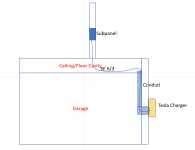wwhitney
Senior Member
- Location
- Berkeley, CA
- Occupation
- Retired
(2020) 210.8(F) requires it for outdoor outlets, but in a garage, I don't see anything in 210.8 or 625.54 that would require GFCI for a hardwired EVSE.2020 requires GFCI for “outlets”, not just “receptacle outlets.”
Cheers, Wayne




